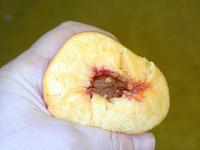Peach, nectarine, apricot, plum and fresh prune.
Chilling injury (CI) or Internal breakdown (IB) is the main limiting factor in the shipping and consumption of peaches and nectarines. This is the most frequent complaint by consumers and wholesalers and the main barrier to consumption.
Loss of flavor, ‘off flavor’, lack of juiciness due to leathery texture or flesh mealiness (), black pit cavity, and flesh browning (FB). In plum and pluots, in addition to the previous symptoms, flesh translucency and red pigment accumulation (bleeding) are typical.
- The long-term solution is to breed cultivars using genomic tools that are not susceptible to CI. This work is in process, pursued by a multistate effort (RosBREED).
In the meantime, follow these guidelines:
- Market susceptible cultivars according to their potential postharvest life.
- Use the controlled-delayed-cooling (‘preconditioning’) treatment to delay onset and reduce intensity of CI symptoms. When this ‘preconditioning’ protocol is executed properly, fruit postharvest life almost doubles.
- Storing below 0°C (32°F), but above the freezing point, and avoiding the ‘killing temperature range’ 2 to 8°C (36 to 46°F) are beneficial to delay CI symptoms and extend market life.
- Enforce proper postharvest practices during handling, transportation and retail handling. Keep fruit near 0°C (32°F) during storage and transportation, and avoid fruit exposure to temperatures between 2 and 8°C (36 and 46°F) (‘killing temperature range’) during transportation and retail handling.
- Educate fruit handlers (warehouse, retail handlers and consumers) on how to reduce CI incidence and intensity.
Crisosto, C.H., Mitchell, F.G. and Ju, Z. (1999). Susceptibility to chilling injury of peach, nectarine, and plum cultivars grown in California. HortScience 34, 1116-1118.
Crisosto, C.H., Garner, D., Andris, H.L. and Day, K.R. (2004). Controlled delayed cooling extends peach market life. HortTechnology 14, 99-104.
Crisosto, C.H., Crisosto, G.M., and Day, K.R. (2008) Market life update for peach, nectarine, and plum cultivars grown in California. Advances in Horticultural Science, 22, 201-204.
Crisosto, C.H., Lurie, S. and Retamales, J. (2009) Stone fruits. In: Yahia, E.M. (ed.), Modified and Controlled Atmospheres for the Storage, Transportation, and Packaging of Horticultural Commodities. CRC Press, Boca Raton, FL, pp. 287-315.
Martínez-García, P.J., Peace, C.P., Parfitt, D.E., Ogundiwin, E.A., Fresnedo-Ramírez, J., Dandekar, A.M., Gradziel, T.M. and Crisosto, C.H. (2011) Influence of year and genetic factors on chilling injury susceptibility in peach (Prunus persica (L.) Batsch). Euphytica, 185, 267-280. DOI 10.1007/s10681-011-0572-1.
Dhanapal, A.P., Martínez-García, P.J., Gradziel, T.M. and Crisosto, C.H. (2012) First genetic linkage map of chilling injury susceptibility in peach (Prunus persica (L.) Batsch) fruit with SSR and SNP markers. Journal of Plant Science and Molecular Breeding 1, 1-12.
Pons Puig, C., Dagar, A., Ibanez, C.M., Singh, V., Crisosto, C.H., Friedman, H., Lurie, S. and Granell, A. (2015) Pre-symptomatic transcriptome changes during cold storage of chilling sensitive and resistant peach cultivars to elucidate chilling injury mechanisms. BMC genomics, 16, 245-279.
Crisosto, C.H. and Kader, A.A. (2016) Peach. In Gross, K.C., Wang, C.Y. and Saltveit, M. (eds.) The Commercial Storage of Fruits, Vegetables, and Florist and Nursery Stocks. USDA Agriculture Handbook 66, pp. 466-470.





